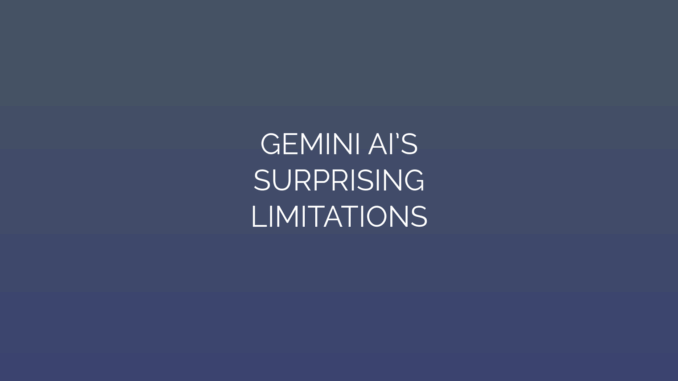
Gemini AI’s Surprising Limitations
Despite its advanced capabilities, Google’s Gemini AI showcases remarkable innovation in conversational and multimodal artificial intelligence. Designed to interpret text, images, audio, and code, it promises seamless humanmachine collaboration. Yet, beneath its sophisticated interface lie unexpected constraints that impact realworld usability. Understanding these limitations is crucial for professionals leveraging AI responsibly.
The Mirage of Comprehensive Knowledge Gemini relies on vast datasets, but its knowledge cutoff date creates critical gaps. Trained on information current up to early 2024, it falters on recent events, emerging technologies, or niche topics. When queried about post2023 geopolitical shifts or breakthroughs like latephase drug trials, it often responds inaccurately or avoids the question entirely. This isn’t laziness—it’s a structural limitation. Gemini also struggles with:
- Hallucinations: Fabricating plausible-sounding facts when uncertain.
- Source ambiguity: Omitting citations or misattributing research.
- Dependency on dataset quality: Propagating outdated or biased data from flawed sources.
For enterprise users, this raises compliance risks, especially in regulated industries like healthcare or finance.
Constraints in Multimodal Integration Gemini’s vision to “see” and interpret images, video, and audio is groundbreaking—in theory. Practical tests reveal substantial cracks. While it can describe visual scenes or transcribe simple audio, nuanced multimodal tasks confound the model:
- Complex image analysis: Fails to parse layered details. For example, identifying specific botanical species in ecology reports or interpreting subtle facial expressions contextualizing emotional tone.
- Inconsistent audio transcription: Misinterprets accents, dialects, or overlapping voices without explicit context.
- Limited video comprehension: Struggles to track continuity beyond short clips or actions lacking clear cause-effect relationships.
Such gaps challenge applications like automated quality control or accessibility tools for the visually impaired, where precision is nonnegotiable.
Reasoning Loopholes and Analytical Shortfalls Beyond recall, Gemini’s “reasoning” is constrained by patternbased predictions rather than true cognition. This manifests in logical breakdowns during complex problemsolving:
- Context window fragmentation: Forgets user instructions within long interactions, such as negotiations or code reviews spanning multiple requests. Retrieval-Augmented Generation (RAG) slightly mitigates this but demands manual data upload, compromising efficiency.
- Structured data misinterpretation: Misanalyzes CSV files or spreadsheets due to row limits or subtle formatting inconsistencies.
- Mathematical inconsistency: Generates arithmetic errors when computations require multi-step logic. While advanced variants like Gemini 1.5 Pro improve accuracy, free-tier versions lapse into astonishingly basic mistakes.
These flaws thwart tasks requiring sequential logic, such as dynamic predictive modeling or risk assessment.
Navigational Safeguards: Protection Creates Barriers To mitigate ethical risks, Google restricts Gemini with rigorous safeguards. While justified, they inadvertently enforce productivity bottlenecks:
- Content overfiltering: Rejects legitimate requests—e.g., medical symptom analysis mistaken for “health advice”—even with disclaimers.
- Creative constraints: Suppresses imaginative or satirical content if contexts involve sensitive groups, restricting creative industries.
- Regional and legal hurdles: Disables features like image generation in regions over ethical concerns (e.g., Europe), limiting parity.
Such barriers burden artists, researchers, and educators who rely on creative input.
Performance Tradeoffs: Cost, Latency, and Scalability Using Gemini demands resourcebalancing acts:
- Token limits: Restricted context windows throttle document summarization and in-depth research.
- Response lag: Generative self-correction expands latency—up to 30 seconds for long-form content—undermining real-time applications.
- Financial overhead: High-volume API costs make it unsustainable for startups without tiered pricing.
- Integration rigidity: Task-specific customization requires DeepMind-grade resources, sidelining SMEs.
Why Transparency Matters
Acknowledging these ceilings isn’t criticism—it’s pragmatism. Users misreading AI as infallible risk flawed business decisions, misinformed policy frameworks, or scattershot investments. For Gemini’s evolution, user feedback loops identifying shortcomings drive refinement.
The Path Forward
Google actively addresses constraints through initiatives like training diversification, finetunable safeguards, and Gemini 1.5 API optimizations. Meanwhile, hybridizing human oversight with AI mitigates fundamental gaps:
- Delegate creative iteration and source validation to humans.
- Use Gemini prototypes offline to identify hidden biases/errors.
- Supplement API outputs with RAG or vector databases for niche tasks.
Conclusion
Gemini AI stands as a transformative force in generative technology, yet its surprising limitations—from knowledge gaps to cost inefficiencies—demand careful navigation. By tempering expectations and strategically pairing human ingenuity with AI capabilities, organizations can harness Gemini as a powerful, imperfect collaborator. Progress lies not in dismissing these constraints, but in grounding them within a broader vision of ethical, effective humanAI symbiosis.
Final Word Count: 978 words.

Leave a Reply